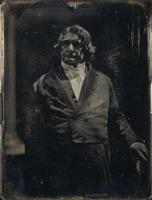Thursday, July 21, 2005
If It Weren’t So Bright Outside
 And if I weren’t feeling so hot and lazy this week, I would write something resembling a review of two cool, dimly-lit shows I’ve seen recently: James Turrell at Pace Wildenstein and Young America: The Daguerreotypes of Southworth & Hawes at the International Center of Photography.
And if I weren’t feeling so hot and lazy this week, I would write something resembling a review of two cool, dimly-lit shows I’ve seen recently: James Turrell at Pace Wildenstein and Young America: The Daguerreotypes of Southworth & Hawes at the International Center of Photography.On the surface, the two couldn’t be more different. At Pace, Turrell presents two wonderful light projections from 1968, Juke Green and Alta (pink) (at left), and 11 not-so-great recent holograms. Less than a mile to the south and west, ICP has put together a beautifully lit show of daguerreotypes that emerged from the legendary Boston studio well over a century ago.
As different as these shows are, though, it wouldn’t take much to draw out an interesting set of similarities. One that comes immediately to mind: both Turrell and the daguerreotypists used new tools for reflecting light in a way that pushed the technology beyond mere commercial applications.
 As evidenced by their legendary portrait of the imperial Chief Justice of the Massachusetts Supreme Court Lemuel Shaw (at right), in the end it’s the work of Southworth & Hawes that comes across as the more engaging. Their work elevated the daguerreotype more than Turrell’s has elevated the hologram. (Interesting piece of trivia not mentioned in the exhibition: Lemuel Shaw was also Herman Melville’s father-in-law.)
As evidenced by their legendary portrait of the imperial Chief Justice of the Massachusetts Supreme Court Lemuel Shaw (at right), in the end it’s the work of Southworth & Hawes that comes across as the more engaging. Their work elevated the daguerreotype more than Turrell’s has elevated the hologram. (Interesting piece of trivia not mentioned in the exhibition: Lemuel Shaw was also Herman Melville’s father-in-law.)With his moving mountains and all, you have to give Turrell his due, but the holograms are some of his weakest work to date. You would never know that from the show’s price list, though. When I visited the gallery, shortly after the show’s opening, nine of the 11 had either sold or were on hold. With his light transmission holograms being offered at $135,000 and the light reflection holograms at $85,000 (but available on the secondary market for less than half that price), the two much, much better vintage projection pieces come across as relative bargains at $300,000. And both are still available.
My take away (since at those prices I’m not taking away any of Turrell’s pieces): this small show demonstrates that Turrell’s work is much stronger when its driving illusion exists in the viewer’s sense of perception than when it exists in the technology of an object external to the viewer.